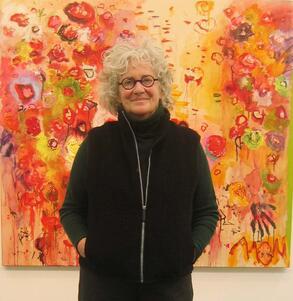Joan Snyder
Our Foremothers is a print that was commissioned by The Jewish Museum in New York City. I decided to make a print that included the names and histories of every woman who was mentioned in the Old Testament, Jewish as well as non–Jewish women. I included the names of the women in my own family, including my partner Maggie, my daughter Molly, my grandmother Dora, my mother Edythe, my sister Suellen, and my niece Hannah. The print was complicated to do… almost like composing a symphony. It includes lithography, etching, and woodblock. The woodblock section was the part of the project that was the hardest. Each piece of wood was cut into a different shape. After the pieces were inked, each with a different color, they had to be put back together like a jigsaw puzzle and then printed on the paper, on top of the already printed lithograph and etching sections.
I would say that this is a feminist piece (made by a feminist, a Jew, and an American). The histories of the women in the Bible were nothing if not those of women ferociously pioneering for the rights of females. The print reflects those histories. They fought for, among other things, women’s right to own property, women’s inheritance rights, women’s struggle against abuse, and on and on. The print names names and then tells briefly the history of each woman mentioned in the Bible. I loved doing this print. I love celebrating our foremothers.
Joan Snyder’s introduction into the New York art world began with a series of “Stroke” paintings completed in the 1970s. These paintings were included in the Whitney 1973 Biennial and the Corcoran 1975 Biennial, and were the basis of her first solo shows in New York City, San Francisco, and Los Angeles. Although often placed under various umbrellas of art movements—abstract expressionism, lyrical abstractionism, feminism—Joan Snyder’s work has never been easily categorized. The changing nature of Snyder’s work, with its combination of personal iconography, female imagery, aggressive brushstroke, and accomplished formalism, has kept her steadily untagged. For this reason, among others, she remains a highly regarded painter and an influential and important figure in the visual arts.





